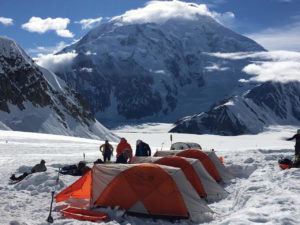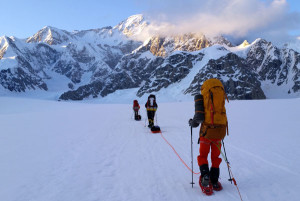The question “When is the best time to climb Denali” is not an easy one to answer, and one that we get nearly every day here at the Mountain Trip HQ, what we call the “million dollar question”. Todd Rutledge, co-owner of Mountain Trip and Denali guide for over 20 years put together the following article to address that question.
Here’s Todd’s take on Denali the million dollar question, “When is the best time to climb Denali?”
Over the years, I’ve started up Denali in every week of the season from May 1 – June 26th and have watched weather trends on the mountain for the past 22 years in the hopes of determining when the “best” time to climb might be. My conclusion is that I’ve not seen any benefits to one time of the conventional season that create a compelling reason to choose that time over another.
Statistically, more climbers have reached the top during the first week of June than any other time. I’m not certain how or why that trend got started, but I hold the belief that, with the advent of the internet and its associated information pipeline, a sort of “self-fulfilling prophesy” has been created. We have tracked our teams’ summit success and have not seen any spike in time when more teams reach the top than any other week of the season.
I think you can make some generalizations about what sort of conditions you might encounter at any given time of the season. Of course, every time I make such a generalization about the Alaska Range, I am proven wrong. Case in point- I think it was the 2007 season when the lower glacier had a much greater crevasse hazard in early season than it did in late June or July. Those conditions flew in the face of conventional wisdom, but generalizations did not account for the rain that fell on the glacier in January or the tremendous wind event that whisked snow away in mid-April. Ultimately, it’s a coin toss…
If I were to generalize, I’d say there are three sub-seasons:
Early (before May 7+/-):
- Temperatures are colder at all elevations (In the last few years this has certainly been the case; however, from 1998 – 2003, we wore t-shirts on the lower glacier, and in 2011 our early season team wore light layers on their move to 14,200’.
- You’ll probably encounter less snow up high
- Conditions, likely windpacked/blue ice conditions above 15,000′
- You’ll encounter fewer people, which can add to the wilderness feel, but reduce your “safety net,” as you might be climbing on your own
- You’ll probably need to build your camps, but this isn’t necessarily a bad thing…
- Lower glacier may or may not have any lower crevasse hazard (this really depends on the year! If the Range has a low-snow winter or a big wind event in April, it could potentially be more hazardous than in late season)
Mid (peak) season (roughly May 7 – June 10):
- Generally warmer down low, getting HOT as you get later into May
- Snow will start falling up high and can be considerable by late May, even to the point of delaying your move to high camp due to avalanche hazard
- The majority of climbers for the season will be on the mountain (the historic “peak week” starts +/- May 21- with 275 climbers one year!)
- Mixed bag of weather, like always up there
- You might move into camps, saving effort, but the camps might be gnarly…
- Lower glacier is generally in good shape, but not always!
Late season (after mid-June):
- Temperatures can be very hot up to 14K and it can potentially rain on the lower glacier
- It can snow a lot up high, making for great travel (if you’re not breaking trail!), but also avalanche hazard
- You’ll see fewer other climbers, but many more than on April climbs. You might be relatively alone towards the end of your climb.
- Prepare for mixed weather, as always…
- You generally lots of established camps to choose from, so pick and choose
- The lower glacier can be a minefield or can be in decent shape. You might need to wait a day or two for a freeze before traveling from 7800 back to base camp on your descent.
The Human Variable
The human variable is something to definitely consider. First of all, wrap your head around the fact that the West Buttress route is not really a wilderness experience unless you head up in April. Embrace the social aspects of all the other climbers, as you are all in it together! It can be a lot of fun to meet climbers from around the world, and often, you might find yourself in a conversation with some of your climbing heroes who are on the mountain attempting a rad new route.
If 200+ climbers fly on in a given week and you have five days of bad weather, they’ll get stacked up somewhere. We’ve seen teams turn back on summit day because they were too far back “in line” on the Autobahn, and it would have taken them 3-4 hours to climb to Denali Pass, a typically 1.5 – 2 hour jaunt.
Early Season Thoughts
Guide friends really like the early season time frame and we have had climbers comment that their trips beginning in mid to late April have been amazing experiences, but you need a really good day to summit, as it can be really cold up high. It’s not ALWAYS cold up there, and we had a team summit from the north on May 1 a few years back, on a relatively warm day due to an inversion that settled over the mountain.
A consideration is that there is something like 7 minutes more sunshine on you each day leading up to the Solstice. After early May, there is plenty of sunshine to warrant a long summit day, but trips beginning in mid to late April will find themselves with noticeably less sunshine, which translates to the need for a “better” day to summit than you might need a couple weeks later.
Skiing
Later is better if you want to ski on the upper mountain. This only pertains to making turns, as capable skiers should consider traveling on skis at any point of the season. As the days warm up, the snow level rises and you’ll find better conditions for schussing on the slopes you’ll want to ski.
Last Thoughts
When considering advice from other climbers as to when is the “best time” to climb, I’d only caution you that anyone can have a relatively easy or hard time on their Denali climb. It is almost as easy to have a couple of easy or hard trips, perhaps leading someone to come away thinking that all the hype is just that (easy or hard). Folks who have seen the mountain in all its conditions might have different opinions on aspects of the experience.
So… need a coin to flip?
[/vc_column_text][/vc_column][/vc_row]





Great article!!
Do you mean that there are 7 minutes of more sun each day leading up to the Solstice? Your article said that there will be 7 days less leading up to it. Excuse me if I am wrong.
Thanks for pointing that out Jared, I’ve read that article dozens of times and not noticed that we said less instead of more… Corrected.
This article is well written by a pro. Thank you for sharing your knowledge.
About how long does it take to climb Mt Denali? And how advanced of a climber do I need to be? Is it necessary to hire a guide?
Hey Kimball,
I’d not recommend going for the summit proper before day 12, to give your body sufficient time to acclimatize to 6000m. That’s in a perfect scenario, so when you add in some time to wait out inclement weather, and a couple of days for the descent, most folks find that three weeks is a reasonable amount of time to carve out for an ascent. You should have a solid foundation of basic mountaineering skills. I’d suggest reading the part of our West Buttress web page entitled “Expectations” carefully, as it will outline those skills. Plus – don’t underestimate the physical rigors – it’s a hard, challenging endeavor.
Lastly, nope – you do not need to hire a guide. Plenty of folks climb Denali without guides each year. A guided ascent can be a good option for anyone who hasn’t had the opportunity to put in the necessary apprenticeship of climbing a bunch on other peaks, so as to develop the repertoire of skills necessary to determine where is a good place to camp, how to establish that camp, how to navigate Alaska Range glaciers (they’s bigger and gnarlier than most!), etc, etc… At the end of the day, Denali is a very different mountain than most, and it deserves respect, but if you put in the time to understand how to climb her responsibly, it can change your life. It’s an amazing experience.
Hope this helps!
Cheers,
Todd Rutledge
Guide/Director, Mountain Trip